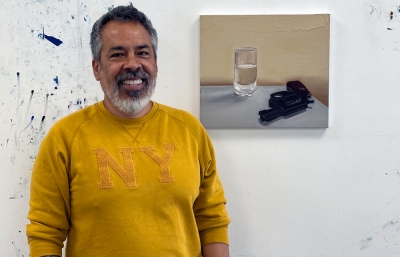Now I’d like to know more about your studio. How long have you had it, has it changed, and what are the necessary elements? Anything to enhance your mood?
I used to have a studio separate from my home. I always thought I needed that divide between work and personal life. Yet recently I moved to this beautiful place in Amsterdam, an old garage converted into a loft with lots of daylight and space, where I also have my studio. I just make sure I take enough breaks in between, get out the door, and into nature. Other than that, the paintings are great company and comfort, so I like to surround myself with them. Having them around also helps me start a new painting, a new story. Then, while I paint, I always play music, mostly music in a language I don’t understand so that I can focus more on the feelings that the song brings up rather than the lyrics. Musicians I currently listen to are Robbie Basho, Miles Davis, Fela Kuti, and Naseer Shamma. I would say my studio is an organized mess, and I like it that way.
I love seeing your pup in so many photos. Balou must be a steadying presence. As an obsessed dog mom, I’d love to know more about what your pet means to you.
I never had this pressing desire to have kids, but I always knew I wanted a dog. Balou is a rescue dog from Greece, and yes, he does bring me a lot of peace. He’s a grounding presence for sure because he really keeps me in the moment, and we go for many long walks in nature which keeps me sane and happy.
Do you think there is something that characterizes Dutch artists, or I guess, the creative mood of the Netherlands? I have a stereotype of the Dutch as straightforward, precise, and very cool-headed, as opposed to an emotional Mediterranean.
When it comes to my art, I don’t identify that strongly with the heritage or place where I grew up and live. I would say I’m surrounded by people who are very much in touch with their emotions. It’s more about mindset than place for me,
You seem very happy in your career and day to day, any place you dream of visiting, or anything you dream of doing?
Not necessarily. I’m very happy with where I am in life and I don't like to look too far into the future. I just aim to be present in the here and now. And excited to work on my first book and solo show in collaboration with Alex Daniëls of Reflex Gallery in Amsterdam, which will take place in 2024.













